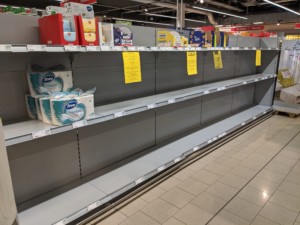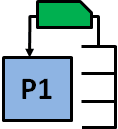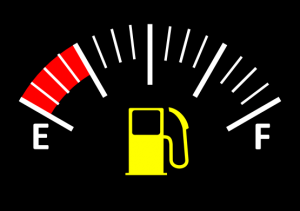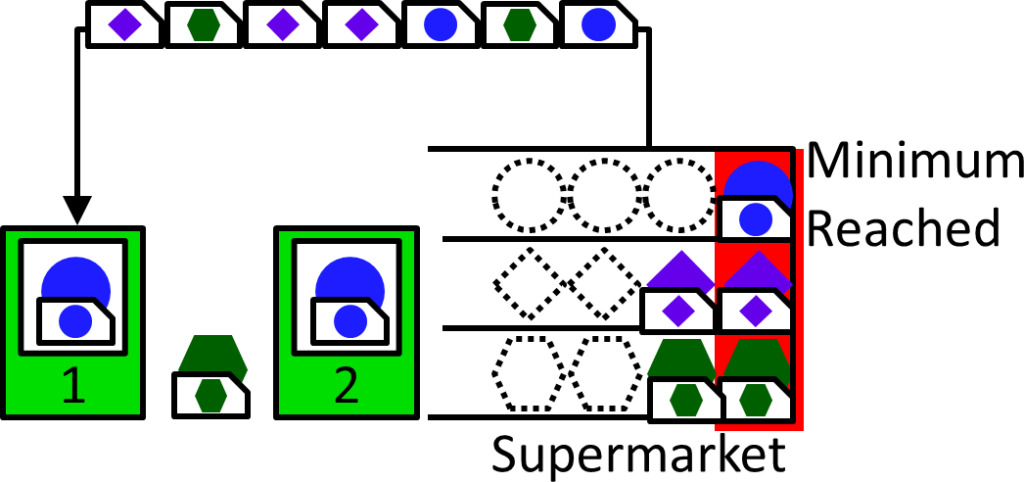
The kanban formula (or estimation) helps you determine the number of kanban. All of these should fit in the supermarket, hence the maximum in the supermarket represents all kanban. Many supermarkets also have a minimum inventory level. Unfortunately, there is little information on how to set the minimum. Time to take a deeper look on how to set and use the minimum level in the supermarket. In this first post I will look at how to use a minimum level in a supermarket. The next post will look at how to determine a good minimum level.
Introduction
 A supermarket is the inventory at the end of a kanban loop. Whenever a part leaves, a signal is given to replenish this material. This signal is the kanban. Hence, the maximum inventory in the supermarket is the inventory represented by all kanban.
A supermarket is the inventory at the end of a kanban loop. Whenever a part leaves, a signal is given to replenish this material. This signal is the kanban. Hence, the maximum inventory in the supermarket is the inventory represented by all kanban.
It is often recommended to also add a minimum level to the supermarket. This is usually helpful. The term minimum, however, is unfortunate and a bit confusing. The real “minimum” in a supermarket is zero. If you need parts, you should use any material that is in the supermarket until you run out.
What we mean here by minimum is more of a warning level. Reaching the “minimum” level should give you a warning that you run out of stock soon. Even though the name is a bit confusing, to stay consistent with pretty much the rest of the world, I will also call this warning level a minimum.
Hence, the minimum is a warning that you will be out of stock soon. This will give you time to react and prevent an actual stock out. This will give you time to do firefighting, even though I don’t like firefighting much. Also, please note that the minimum is part of the total inventory limit represented by all kanban for this part type, not in addition to the total.
An Analogy

To illustrate this, let me give you an analogy that you are all familiar with: the gas tank in your car (or similar for your battery if you have an electric car). Usually this is displayed as a fuel gauge somewhere on your dashboard. This fuel gauge includes a minimum warning, sometimes called the reserve. If your fuel level falls below the minimum, a warning light will come on and there may be a warning sound. This gives you time to refuel before you are stranded.
However, if the warning light goes off when you have only three kilometers’ worth of fuel left, then it is probably way too late. Hence, your minimum is too low. On the other hand, if the warning goes off if there is still half a tank of fuel, then it will be more annoying than helpful. In this case, your minimum is too high. Overall, the minimum level should be set so that you can comfortably reach a gas station without going too much out of your way. Finally, if your warning limit is set at 25% but it blinks five times a day, then your fuel tank is too small! The same goes for supermarkets.

Some people get really excited with adding a minimum and want to do more. Sometimes they add also a yellow area to indicate a pre-warning and a green area to indicate everything is fine. Frankly, I would advise against that. It may be a case of too much labeling, or too much 5S. Again, take your fuel gauge as an example. Do you really need a warning that there is “only 75%” of fuel left? Do you really need a yellow and a green area? If you have too many green, yellow, and red colors, as shown below, it confuses the image and makes people ignore warnings. In any case, don’t expect shop floor people to pay attention.
What to Do If You Reach the Minimum?
If you reach the minimum, you have too few kanban with material of this part type in the supermarket. There are many possible reasons for that. It could be that you cannot produce due to lack of material. In this case, the issue should have been escalated already, but now is a good time to escalate again with even more urgency.
Another possibility is that the kanban are merely delayed due to other kanban of other parts being in front of them. This is much easier to fix. Simply fast-track the needed kanban to the front of the queue for production. Make sure to allow enough time for logistics to transport the material. Depending on the urgency, you may also escalate with logistics to accelerate the material delivery for these urgent kanban. If you have a prioritized queue for production anyway, put the urgent kanban in the queue for prioritized parts. In the example pictured, the blue balls have reached their minimum. As part of the escalation, two of the corresponding kanban are moved to the front of the queue for production. However, it can also be argued that moving one kanban would have been sufficient.
In the best case, you will find that many of the needed kanban are already in production and will arrive in the supermarket shortly anyway. Here, you probably don’t have to do anything. The problem is already solved, and material will arrive before you run out. In the illustration here, the blue balls also have reached their minimum. However, there are already multiple blue balls in production, and no action is necessary.
There is a complication for kanban systems with a very long lead time. In such kanban systems, most kanban will be replenished at any given time. Depending on your minimum level, moving a kanban to the front of the queue for production may not be enough. It may be necessary to escalate by prioritizing products already in production. It may be necessary to move parts in production to the front of their respective queues and prioritize their production. This is also shown in the example below. Moving parts already in production will allow lower minimum limits. For systems with very long replenishment times, this may even necessary to avoid overly large minimums, which would result in too many minimum warnings. However, if you can, avoid moving material already in production. Depending on your system, this can increase chaos and can cause subsequent problems. It is also requires much more effort than merely moving a kanban card.
 In my next post I will talk a bit more on what your minimum levels should be. I will also give a few more tips on when you should have a minimum, and how to fine tune the minimum. Until then, stay tuned and go out and organize your industry!
In my next post I will talk a bit more on what your minimum levels should be. I will also give a few more tips on when you should have a minimum, and how to fine tune the minimum. Until then, stay tuned and go out and organize your industry!
Series Overview



If you have a kanban system with two levels, green and red, the former sais that it’s OK to manufacture and the latter that you must. We once had a system like this and everybody “understood” the red level. The green one, however, was used as it’s always allowed to manufacture. The operators used this as a way to avoid re-settings.
We introduced a three zone system, that said that cards in the top zone were not allowed to use. As an operator you had to prioritize the must zone and then the allowed zone. This lead to an improved stock.
I can understand that one argument against such a system could be that we had too many cards in the system. We did check the levels every six months and the total stock turnover was 25 times annually.
Hi Martti, if it works for you, good. Although it may have been better to convince the operators to follow the standard for the sequence (assuming you have one). While I am not 100% sure how your system works, I have a worry that three levels may lead to some unwanted “quirks” in the system.
One question:
Will we need to focus on this issue of minimum level being reached only if at least 2 or more part numbers in the supermarket have reached their minimum levels?.
If only one part has reached minimum, the released Kanbans from the empty slots would already have gone back to the beginning of the process for replenishment.
Even if there is waiting time for lot formation, the lots would have been formed and the kanbans would have triggered start of production.
At this stage, if the availability of inputs is an issue then it should have been realised here and actions for expediting supply of inputs should have been initiated.
Is my understanding correct?
Hi Jay, the minimum level is a warning for one part type. You should react as soon as one part type reaches the minimum. If multiple part types are reaching the minimum, then it seems to be a bigger problem (long breakdown, critical supplier failure, …), making the countermeasures even more urgent.
But you are right on the second point, the first thing to do is to check where your parts/kanban are in the system. If they will be arriving soon anyway, then there is no need to escalate.
From time to time customer demand will cause a stock out. Then draw out, carry and put a red kanban into a second chute for priority (red kanbans ) at next upline model change to speed up recovery for stock outs. Upline gives priority to transfer this product as soon as back into the Down line supermarket.
Hi Christopher, you add extra kanban after there is extra customer demand? That is unusual. Extra kanban help in this case only if you add it *before* the peak demand. Think seasonality. If you run out during a peak adding extra kanban may not help, but it may help to prioritize the existing kanban by putting them in front of the line.
Thank you
Awesome read! The gas analogy really helped me understand the whole Kanban process. I do have a few questions though however, how would a Kanban system work for perishable food options. Would the minimum level be based off the amount of days left till the product goes bad or would it still be based of the inventory levels? I understand that there is still an inventory count but after the x amount of days till product goes bad it is just a waste especially if you have high inventory count left. The other question I have is how often do you check minimum levels and is it common to adjust the levels?
Hi Phil, perishable are a bit more difficult. I have a subchapter on this in my upcoming book on pull production. High inventories buffer against stock outs, but lead to spoiled products. Let me quote (preview) one paragraph on the maximum inventory, but this also applies similarly to the minimum:
“There are multiple angles on how you can address such a problem. You could try to reduce the replenishment time, including lot sizes, as well as reduce fluctuations to get the inventory limit down. You may also reduce the inventory limit anyway and live with the higher risk of stock-outs. If both are not possible, as for example with critical medication, you may have to dispose of expired products.“